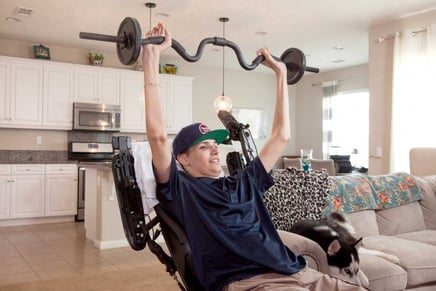Stem Cells: Mid-Trial Hopefulness - Blog - Reeve Foundation
You know how hard it can be, managing expectations. I realized a long time ago that most readers of this blog don’t care to wade too deeply into detail. Biology is difficult. Understanding brain and spinal cord function, or loss of function, requires a baseline of knowledge that takes time and effort to attain. I try my best to keep an eye on the hope meter, the big barometer of progress, the potential for real clinical application. Thus, I base my reporting on what researchers are actually reporting. I try to minimize the cartoonization of neuroscience. If you read or listen to the news, you know it ain’t easy.
Earlier this month a press release described results for a young man in a clinical trial of embryonic stem cells. Kristopher "Kris" Boesen had a car wreck last March in Bakersfield, California. He broke his neck and wound up in Los Angeles at Rancho Los Amigos National Rehabilitation Center, which is collaborating with the USC Keck Medical Center. Boesen fit the criteria and was recruited to participate in the Asterias SCIStar trial – 10 million cells were injected in his spinal cord at around two weeks post injury.
The cells are called AST-OPC1. They are oligodendrocyte progenitor cells – derived from human embryonic stem cells but allowed to evolve toward becoming nerve support cells. In animals OPCs have demonstrated, in company lingo, “potentially reparative functions that address the complex pathologies observed at the injury site of a spinal cord injury.”
 This is the continuation of the so-called Geron trial, which dosed 2 million cells in five patients beginning in 2010 before the company abandoned the trial in 2011. Asterias, a subsidiary of BioTime, acquired the rights to the cell line and with the help of a $14.3 million grant from the California Institute for Regenerative Medicine (CIRM) rebooted the study.
This is the continuation of the so-called Geron trial, which dosed 2 million cells in five patients beginning in 2010 before the company abandoned the trial in 2011. Asterias, a subsidiary of BioTime, acquired the rights to the cell line and with the help of a $14.3 million grant from the California Institute for Regenerative Medicine (CIRM) rebooted the study.
It is now ninety days post-injection and Kris has had an outcome not expected for a quad. Let’s hear the headline: “Paralyzed Man Regains Use of Arms, Hands After Experimental Therapy At Keck-USC.” You may think this is from Asterias, or from the Huffington Post. No, that was the headline from USC’s press office.
Kris got some recovery. They’re saying it’s way better than the baseline average for his level of injury. Maybe the stem cells are kicking in. Can you link his improvement to the trial, really? What if he got better on his own? Read this, and remember it is not a science report, it’s a press release:
Two weeks after surgery, Boesen began to show signs of improvement, according to [neurosurgeon Charles] Liu. Three months later, he's able to feed himself, use his cell phone, write his name, operate a motorized wheelchair and hug his friends and family, according to his doctors.
“As of 90 days post-treatment, Kris has gained significant improvement in his motor function, up to two spinal cord levels,” said Dr. Liu. “In Kris’ case, two spinal cord levels means the difference between using your hands to brush your teeth, operate a computer or do other things you wouldn’t otherwise be able to do, so having this level of functional independence cannot be overstated.”
I guess overstatement is relative. Measure your own expectations.
What’s the good of this mid-trial reporting and detailed identification of participants and their families? It can’t be good for the slow, careful process of discovery. It introduces all sorts of bias into the mix. It’s good for Asterias, the publicly traded company that saw its share price bump up after the news. It won’t hurt future patient recruitment – why wouldn’t you do this experiment if your arms and hands are for sure coming back? It feels good for USC and Rancho, which had no previous profile in stem cells.
Is it good for the rest of us? We won’t know until the trial is over and the data is mashed by scientists. But by writing this, I am by default giving them the benefit of the doubt. Maybe the larger doses of cells are really working.
Asterias presented a data update on the trial last week at the International Spinal Cord Society (ISCoS) meeting in Vienna, including the results from Boesen. According to Ed Wirth, Chief Medical Officer for the company:
5 out of 5 patients dosed with 10 million cells have exhibited improved upper extremity motor scores (UEMS) relative to baseline.
At Day 90 of follow up, 4 of 4 patients dosed have improved one motor level on at least one side, 2 of 4 patients have improved two motor levels on at least one side, and 1 patient has improved two motor levels on both sides.
Now the doses are going up another notch. Asterias just got FDA approval to administer 20 million cells in the next batch of patients.
Join Our Movement
What started as an idea has become a national movement. With your support, we can influence policy and inspire lasting change.
Become an Advocate